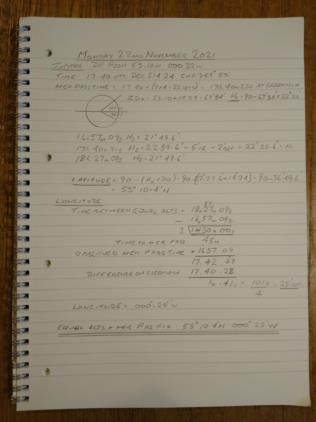
NavList:
A Community Devoted to the Preservation and Practice of Celestial Navigation and Other Methods of Traditional Wayfinding
From: David Pike
Date: 2021 Nov 22, 12:00 -0800
Just to prove I have been reading Little Ship Astro Navigation and not just stacking the bookshelf with it, I thought I’d try a Noon Longitude by Equal Altitudes with my ex RAF C130 Smiths Mk2C pendulous reference periscopic sextant. After waiting about two weeks for the Sun or Jupiter to be visible for two hours at a time, today would finally have been perfect. (This is why I always smile whenever I hear anyone proposing a sextant as a back-up for GNSS failure for an observer near the surface in temperate latitudes)
Unfortunately, by the time I twigged that this was the ideal day and got my gear set up and working it was way to close to noon for the first observation, which ideally should have been not less than 53 minutes before noon. The forecast was still good for tonight, so I left my gear set up to have a crack at Jupiter tonight. This is one of the benefits of using a pendulous reference sextant. You can still use it through the night. Even then, I was still eight minutes late with my first shot.
Despite the slightly late start, I was quite pleased with the result. Latitude was within the rounding accuracy of my calculations and longitude was within about 4nm. This was considerably better than my previous attempts at longitude at noon by plotting a parabola of the Sun. I think this might be because I find it easier to sit a star or Jupiter on the horizontal line of the graticule than the Sun in the centre of it. My working is attached. DaveP







